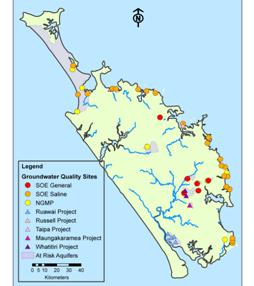Groundwater quality
The Council monitors groundwater quality and change in water quality over time (trends). Seven sites are monitored quarterly (since 1996) through the National Groundwater Monitoring Programme. Samples are taken from the bores located at Houhora, Paparore, Ahipara, Kaikohe, Tutukaka, Glenbervie and Tara and analysed for major minerals, chemicals and metals.
In addition, as part of the SoE groundwater monitoring programme, 29 sites are sampled four times a year. The aim of this programme is to assess the water quality in Northland and identify any changes over time.
While nitrate and bacteria (E. coli) concentrations are probably the most important indicators of the impact of human activities on groundwater quality, many other measurements are made. These include pH, total dissolved solids, pesticides and some metals, e.g. arsenic and iron. The map below shows the locations of groundwater quality sites monitored in Northland.

In general, groundwater in Northland is of a high enough quality that it can be consumed without treatment. During 2009-2010, the results of groundwater quality monitoring indicated that the majority of samples complied with the New Zealand drinking water standards. However, some sites were found to have elevated levels of iron, manganese, bacteria and nitrate.
Ten of the monitoring sites had median iron concentrations above the aesthetic guideline value of 0.2 mg/L. In regards to manganese concentrations, 13 monitoring sites had median values higher than the aesthetic guideline value of 0.04 mg/L, four of them having concentrations very close to the maximum recommended drinking water level of 0.4mg/L. Elevated concentrations of iron and manganese in groundwater are commonly the result of natural processes.
Two monitoring sites in Pataua North and Cable Bay showed elevated chloride and sodium concentrations during summer period. These sites are located in close proximity to the sea and likely to be influenced by saltwater. During summer concentrations of sodium and chloride are above drinking water guidelines, however neither of these bores are used for domestic use.
Results of bacterial analysis undertaken during 2009-2010 indicate that 15 groundwater sites have bacteria present above the drinking water guideline value of <1/100mL. However, only one of these sites, located in Taipā, showed repeated bacterial contamination. Other nearby bores are compliant with the guidelines so this appears to be an isolated event and the Regional Council is investigating this further.
Monitoring has also shown that average nitrate concentrations at all groundwater quality sampling sites are well below the drinking water limit of 11.3 mg/L-N except for one site at Maungakaramea. Nitrate concentrations at this site exceeded the drinking water limit on two occasions in 2009. The elevated bacteria and nitrate levels are due to land use/human activity, and specific investigations are carried out by the Council when elevated levels are recorded.
